Yuzu is one of my all-time favorite flavors and I’m so excited to see it gaining popularity. This post will cover everything you need to know about cooking with yuzu at home, including flavor pairings, yuzu nutrition, and where to buy yuzu products. And of course, there’s plenty of recipe inspiration throughout. I can’t wait for you to get to know this citrus fruit!
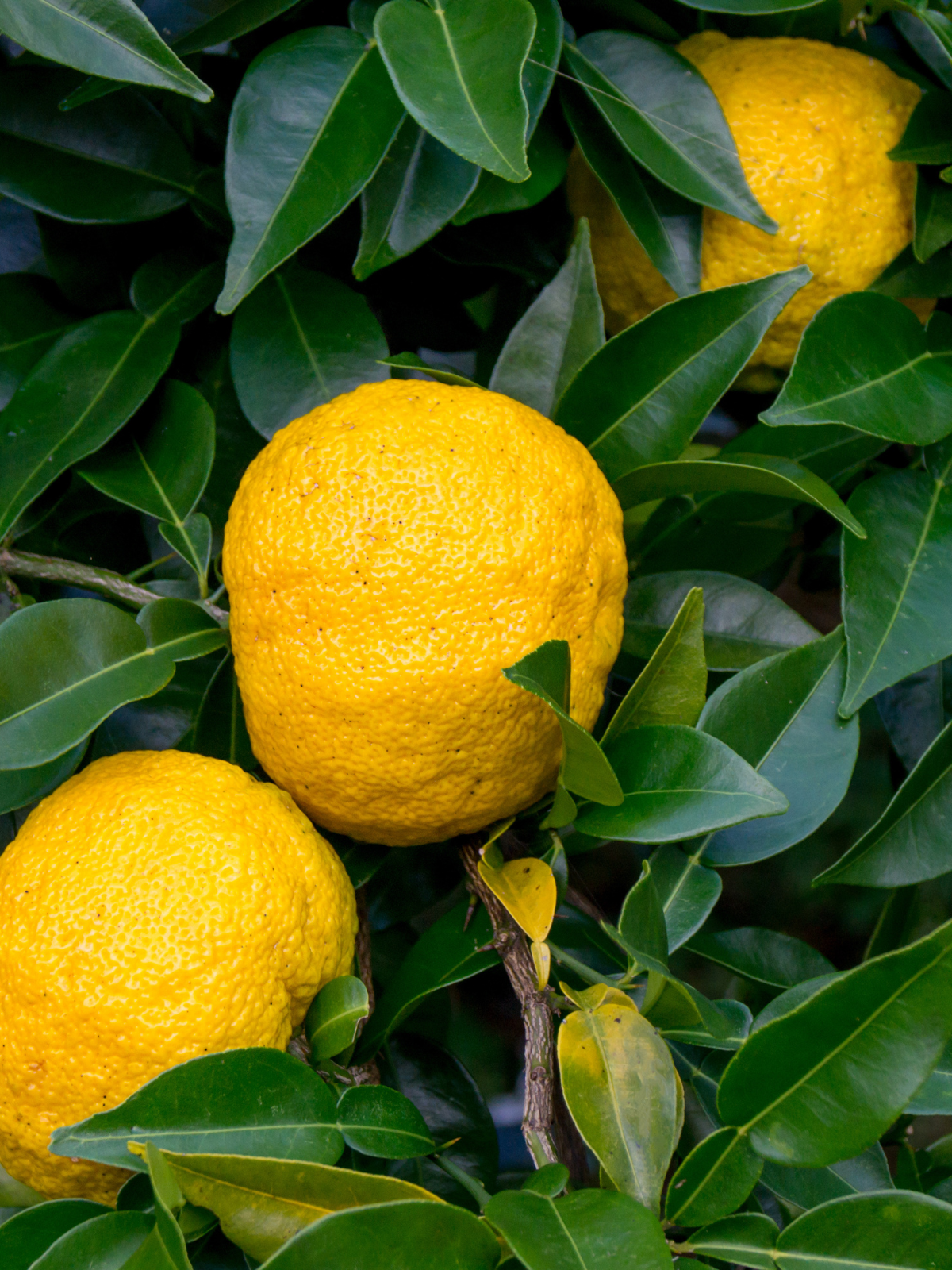
Rewind to just a few years ago and I was pretty much oblivious to yuzu. Even though yuzu shows up in Korean cuisine, I grew up in a rural area of the Midwest. Meaning, I had virtually no exposure to the diversity of flavors and ingredients. Now, I’ve taken a much bigger interest in exploring and reconnecting with my Korean heritage through food and cooking. It hooked me the first time I tried it!
If you’re a newbie to this flavorful fruit, keep reading to learn everything you need to know about cooking with yuzu at home.
What I’ll Cover In This Post:
What is Yuzu?
Yuzu is a type of small yellow citrus fruit native to East Asia. It was originally cultivated in China before spreading to Korea and Japan. Yuzu has been used in these cultures for thousands of years, and by the late 1800s, it finally appeared in the United States. It looks like a small grapefruit or tangerine, with a bumpy, rough outer skin. The color ranges from green to yellow, looking similar to a lemon, with green yuzu being less ripe.
The flavor is unique (more on that below!) and yuzu shows up in a variety of culinary uses. But beyond that, it’s also sought after for its aromatic properties. There’s even a Japanese tradition of bathing with yuzu fruit during the winter solstice (yuzuyu). A yuzu bath is believed to soothe dry skin and guard against seasonal colds.
With yuzu gaining in popularity in the United States, it’s trendier than ever. You’ll find yuzu essential oil added to anything from candles to household cleaning supplies to bath salts, in addition to all the wonderful ways you can use it in the kitchen. And that’s where this guide will focus, so let’s get started with all the juicy facts you need to know about how to use yuzu!
What Does Yuzu Taste Like?
If you’ve never taste yuzu before, you’re in for a treat! It’s such a unique and distinctive flavor, which really sets it apart from other types of citrus.
I think it’s best described as a mashup of lemon juice, sour grapefruit, and sweet mandarin orange. But it has other subtle flavor notes that are floral, adding extra complexity. The bergamot and flower blossom notes also come though in the aroma, which can be quite strong. This is especially noticeable in fresh yuzu juice or yuzu zest. Zest from the yuzu peel or rind can also be pretty bitter, like any other type of citrus. The sour taste is balanced by a hint of sweetness and a little goes a long way in recipes.
This unique flavor has been celebrated in Korean and Japanese cuisine for centuries. In Korean cuisine, it’s also called “yuja” and used for hot or cold yuzu tea (“yuja-cha“) but there are subtle differences in taste and aroma depending on where the fruit is grown.
What Pairs Well With Yuzu?
Since yuzu’s flavor is similar to other citrus fruits, it works well with some of the same pairings. Whenever I’m challenged by what to pair with something, I turn to The Flavor Bible. This book is one of my favorite resources to better understand flavor pairings and spark some creativity in my kitchen. If you don’t already have a copy, I recommend adding it to your shelf! They even have a vegetarian version with expanded recommendations for plant-based cooking.
Here are some of my top picks for what to pair with yuzu:
- For protein pairings, try beef, chicken, or fish or seafood like salmon, scallops, shrimp, or tuna. It is commonly found in ponzu sauce, which can be used for dipping or marinading a variety of savory dishes.
- For side dishes and vegetables, pair it with carrots, salad greens or lettuce, mushrooms, and onions. If used in a sauce or dressing, it can also work well with green beans, broccoli, or Brussels sprouts.
- For fruit combos or sweet dishes, try apricots, caramel, ginger, mangoes, and other sour citrus fruits like lemons, lime, grapefruits, and oranges (especially mandarin orange)
- For beverages, look to green tea. I also like pairing it with something carbonated like ginger beer, tonic water, or fruit-flavored sparkling water
- For cocktails, you can really get creative. Vodka is an easy starting point, but I also like it with rum, gin, Japanese whiskey, or St. Germain (elderflower liqueur). It even works well with blanco tequila, like in this Yuzu Margarita recipe. Look for a yuzu liqueur for even more options for mixing cocktails at home.
- For other flavors and sauces, you won’t go wrong with soy sauce, miso, mirin or rice wine, or hoisin sauce
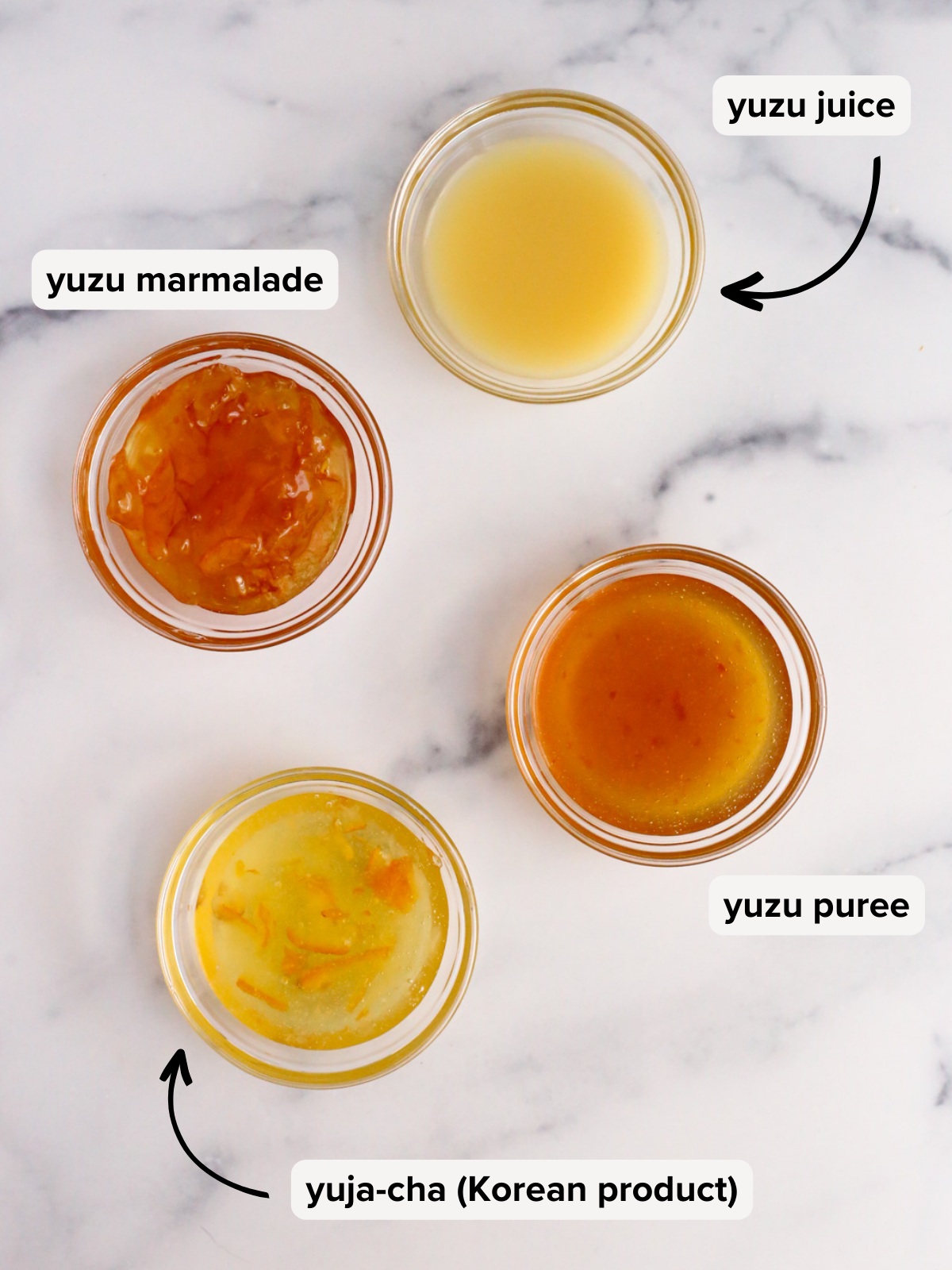
And because of the tart, bitter, or sour flavor, it’s often paired with sugar or some kind of sweetener. But yuzu kosho is also very popular. Yuzu kosho is a spicy citrus paste made by combining yuzu zest and juice with chili peppers and salt. It can be red or green depending on the type of pepper. It’s used as a condiment to add spice and citrus flavor to savory dishes like grilled meat, noodles, and soups or stews.
As soon as I can get a hold of some fresh yuzu fruit, this is one of the first things I’ll try making!
Health Benefits and Yuzu Nutrition
With so many similarities between yuzu fruit and lemons, it’s no surprise they are very similar when it comes to nutrition. Yuzu is a good source of vitamin C, a water soluble vitamin and antioxidant. Vitamin C can help protect your cells from the damage caused by free radicals, which contribute to oxidative stress and can lead to conditions linked to chronic inflammation. Vitamin C is also needed to produce and use collagen, an important protein for bone health, skin health, blood vessels, and connective tissues. Finally, having vitamin C in a meal can improve the absorption of non-heme iron from plant-based iron sources, support a healthy immune system, and maintain better oral health for teeth and gums.
Beyond vitamin C, yuzu also provides smaller amounts of potassium, magnesium, and manganese. It’s low in calories, naturally free of fat and cholesterol, and only provides small amounts of carbohydrates and fiber. Since most people don’t eat the fruit itself, opting for the juice and zest, it’s unlikely to significantly impact overall energy intake.
Street Smart Nutrition Tip: Avoid yuzu fruit and yuzu products if you have an allergy to citric acid. Other potential risks could be damage to tooth enamel or heartburn due to how acidic it is. However, yuzu is perfectly safe to enjoy for the majority of people and poses little risk.
Yuzu in Nutrition Research
Nutrition science is constantly changing, with new studies being conducted, analyzed, and published all the time. I did a quick review of the data currently available at this time. There are several interesting compounds found in yuzu fruit that may have potential health benefits. Among them are:
- Hespiridin and naringin: Also found in grapefruit and oranges, these flavonoids may prevent platelets from sticking to each other and potentially reduce risk of cardiovascular disease. However, this was observed in an animal model so more research is needed to better understand if this effect applies for human health.
- Limonene: An in vitro study found that limonene may have potential anti-inflammatory activity, including inhibiting cytokines, which could support treatment for bronchial asthma. Again, more research is needed to better understand this mechanism.
- Limonene and other volatile aromatic compounds: A very small human trial investigated the effects of inhaling a diffused yuzu essential oil on mood and stress. Since yuzu shares some of the same aromatic compounds as bergamot and lavender, it was hypothesized there could be benefit. The results indicated smelling the yuzu fragrance could lower a salivary biomarker that non-invasively measures psychological stressors. However, there are limits to this randomized crossover study and more research is needed.
- Narirutin: Another animal study investigated whether the flavonoids in yuzu extract could prevent cognitive decline. The results showed that rats who were orally supplemented with yuzu extract showed less cognitive dysfunction as well as normalized insulin signaling in the hippocampus, and improved energy and glucose metabolism.
That last study is a pretty interesting one to me. It’s well established that these plant compounds can be powerful antioxidants and have an anti-inflammatory effect. But I don’t know of much research looking into whether this could be used to prevent dementia or Alzheimer’s disease. There are pretty significant limitations, since we can’t rely on animal studies to know exactly how a similar trial would pan out for human subjects.
But one of the most interesting findings was that the supplemented rats retained more lean tissue and showed improvements in insulin sensitivity. This could be an important finding since dementia patients often struggle with appetite and maintaining their body weight. While it’s too soon to tell if a yuzu extract supplement could prevent unintentional weight loss, it appears there is a potential link there (at least for the types of rats used in this study).
Now that you’re up-to-date on yuzu nutrition and some of the emerging science, let’s get into the culinary uses!
Where to Buy Yuzu Fruit and Yuzu Juice
The only real downside with yuzu is that it can be quite difficult to buy the fresh fruit in the United States. That’s because we actually have a ban on the import of citrus fruit and citrus trees. This helps contain disease and invasive species, which is a very good thing! But unfortunately it makes it almost impossible to find yuzu fruit in most regions. Yuzu is grown in California and growers can ship it, but it can get expensive.
But there’s some good news. Although you can’t usually find yuzu fruit, it’s easier to find yuzu juice or other yuzu-flavored products in an Asian or Japanese market. I’ve yet to see yuzu show up in my local grocery store and I’m not holding my breath for it. But thankfully there are several well-stocked markets and specialty stores with diverse offerings just a short drive away.
Honestly, I think your best bet is probably ordering online. It can save you the time and energy of visiting multiple grocery stores looking for a single, specific item. You should also be aware that yuzu products like pure yuzu juice, extract, puree, or marmalade can be more pricey than other items made with similar fruits.
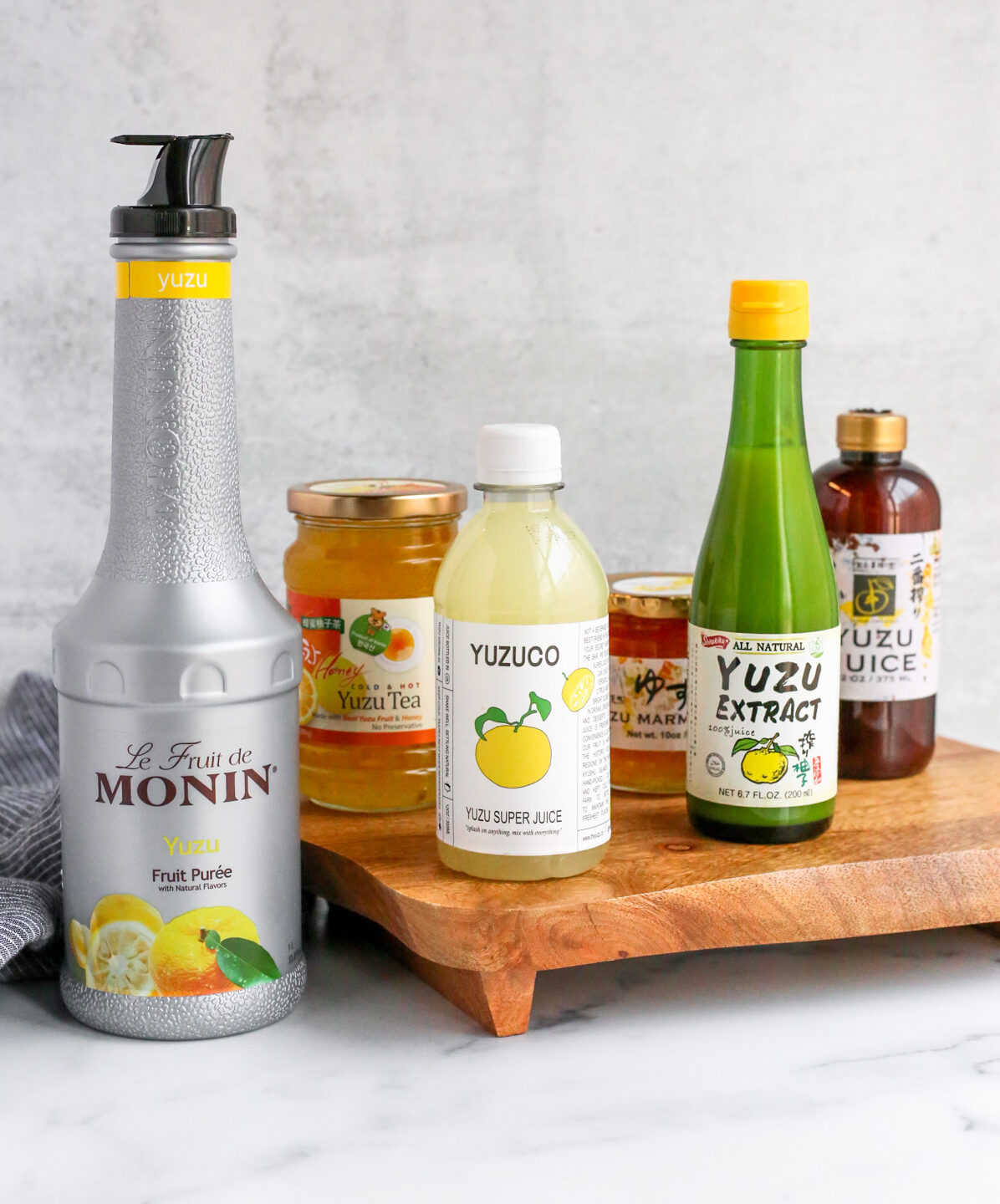
Yuzu Products To Use In Your Kitchen
There are a variety of yuzu-flavored products in addition to everything already mentioned. Because it’s such a trending flavor right now, I think brands and companies are looking for creative ways to use it in their products or menus to give them the edge when competing for attention from foodies like you. Whenever I source ideas in my Instagram Stories, I usually hear how Trader Joe’s or a local restaurant is featuring yuzu in some of their offerings. But there is also an easy way to include it at home! Like I mentioned, online shopping has really opened up the number of options for cooking with yuzu.
Here’s a quick breakdown you can use as a shopping guide to determine what to look for.
Yuzu Juice and Yuzu Extract
Yuzu juice and extract is a good starting point for cooking with yuzu at home. Because it is so similar to lemon juice and other citrus, you can use it in just about any recipe, sweet or savory, that calls for lemon juice. The major difference between yuzu juice and yuzu extract is purity. Yuzu juice may have a combination of lemon juice, grapefruit juice, lime juice, or other citrus flavors present. Meanwhile, yuzu extract is usually 100% juice of yellow yuzu.
And are you familiar with super juice? Invented by bartender Nickle Morris, it’s a less wasteful and more shelf-stable option for citrus juice. It uses a combination of malic and citric acid to replicate the flavors of lemon and lime juice. Many top bartenders have switched over to super juice in recent years. Now YUZUCO offers a version for yuzu super juice with a more extended shelf life compared to 100% yuzu juice or extract.
Another bonus: it’s about half the cost.
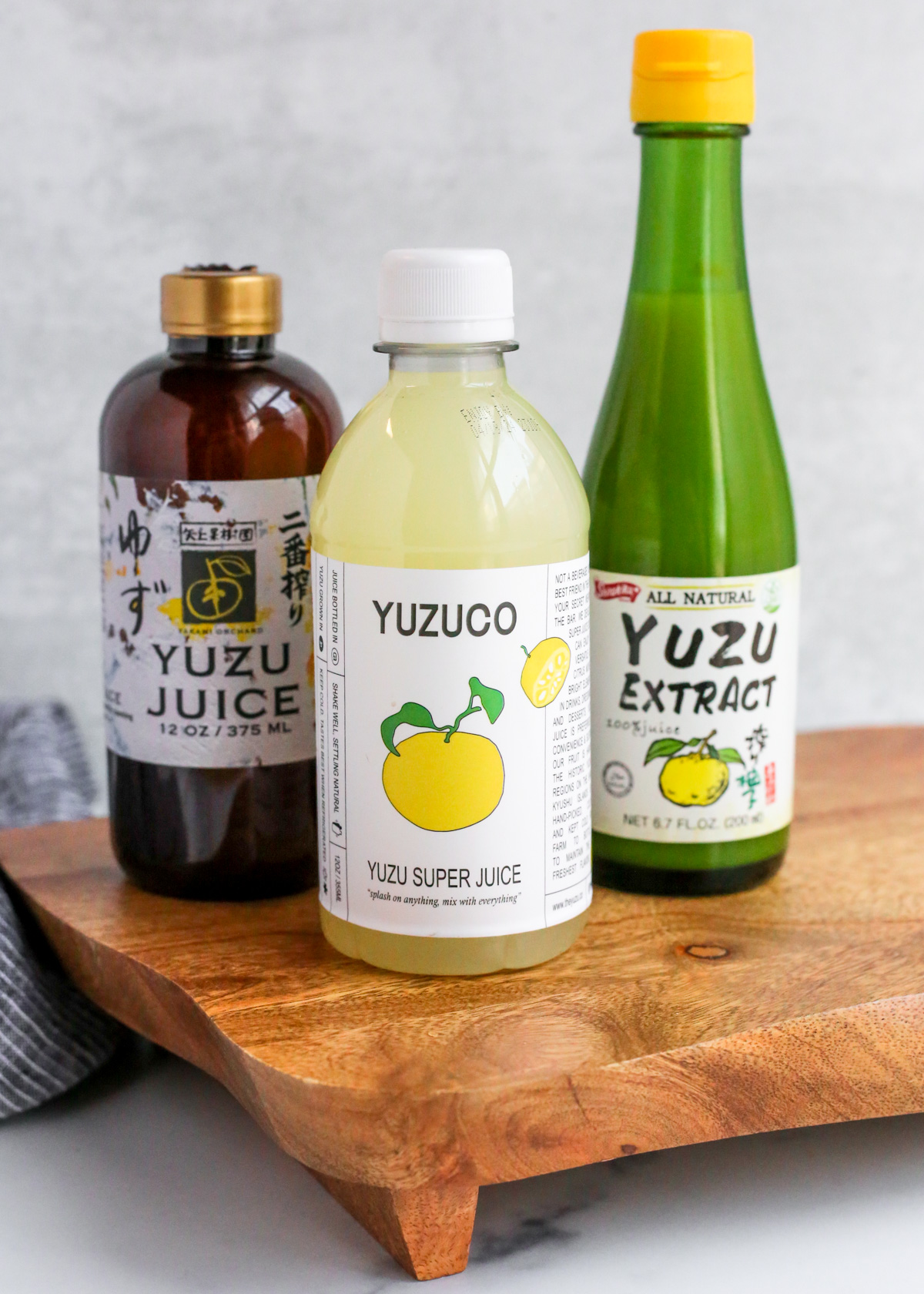
WHERE TO BUY: online, direct from websites, specialty stores, Asian markets or grocers
COST: $12 for 8 fl oz. YUZUCO super juice, otherwise expect to pay about $2.00-4.00 per fl oz
HOW TO USE: A little goes a long way. Often just a splash in a dressing, sauce, marinade, or beverage is enough. Can be added during or after cooking, or added to baked desserts like custards, tarts, for yuzu curd (similar to lemon curd).
Yuzu Puree
Yuzu puree is a much sweeter flavor. There is not a wide range of options in this category, with the most easy to find being Monin’s Yuzu Fruit Puree. The consistency is thick and syrupy, with small, softened pieces of rind. However, note that this is not 100% sourced from yuzu fruit and includes flavor from orange and lemon juice concentrate.
Other yuzu purees seem more suited for foodservice or restaurants, either available in bulk quantities only or need to be kept frozen.

WHERE TO BUY: online, specialty stores
COST: about $25.00 for Monin’s 33.8 fl oz bottle
HOW TO USE: Drizzle into the bottom of a glass for an easy mocktail or sparkling tonic, or add to smoothies, mix into sauces or dressings, and drizzle over ice cream, sherbet, or sorbets. This is also what I like to use for my Yuzu Espresso Tonic.
Yuzu Marmalade
Yuzu marmalade is sometimes called “honey citron” on labels. It’s the thickest and sweetest of the yuzu product categories. Although it’s possible to made your own marmalade to control for flavor and sweetness, the difficulty and expense of sourcing the fresh fruit makes yuzu marmalade a more practical option for most of us (especially if you’re based in the United States like I am).
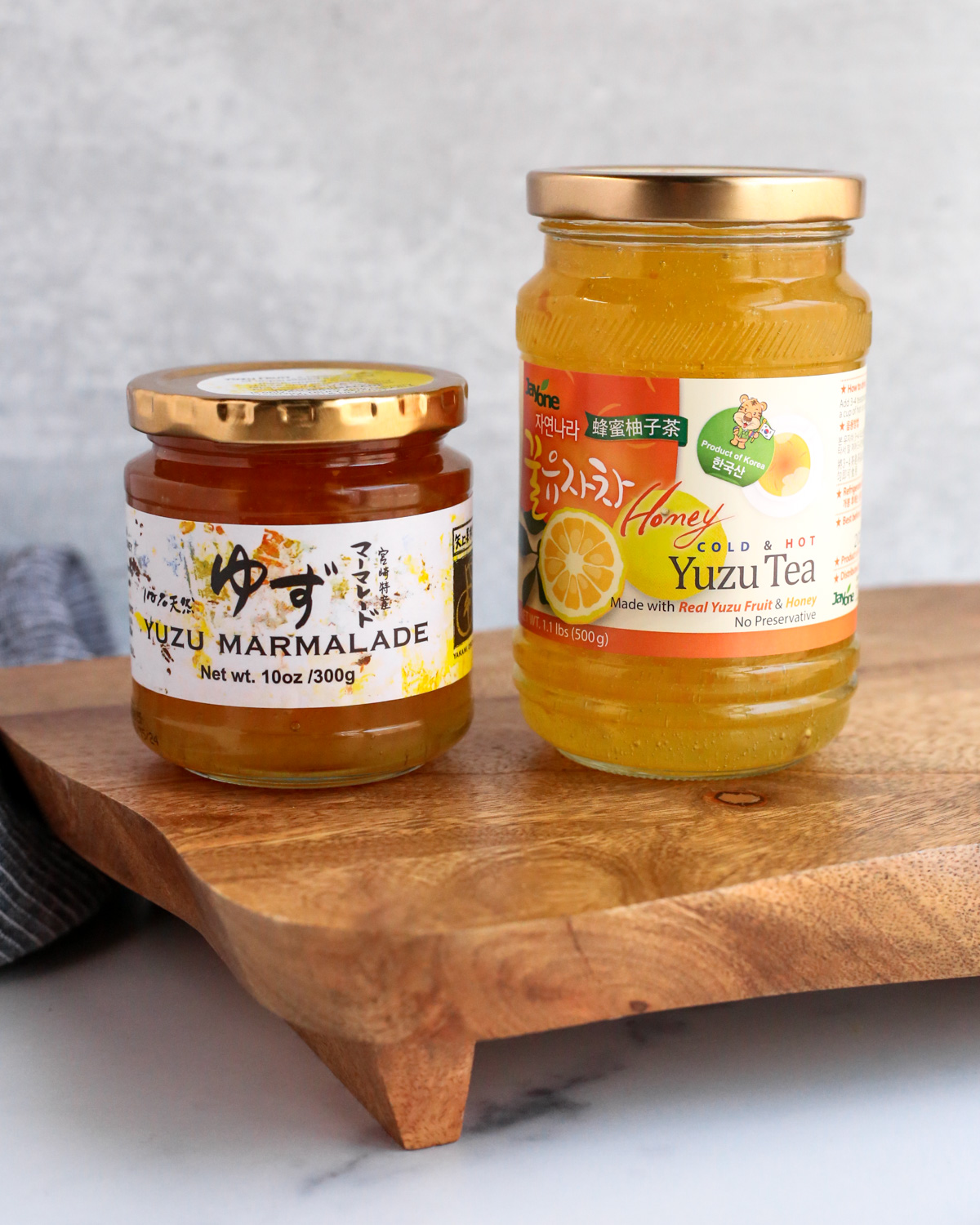
WHERE TO BUY: online, specialty stores, Asian markets or grocers
COST: I found mine in my local Korean markets for $8.99 for a 500g jar (about 25 servings), otherwise $15.00-18.00 online
HOW TO USE: marmalade includes the rinds, so skip this for anything where you want a smooth texture. Use as a spread or the more traditional Korean use of stirring 1-2 tablespoons into hot water for yuja-cha (yuzu tea).
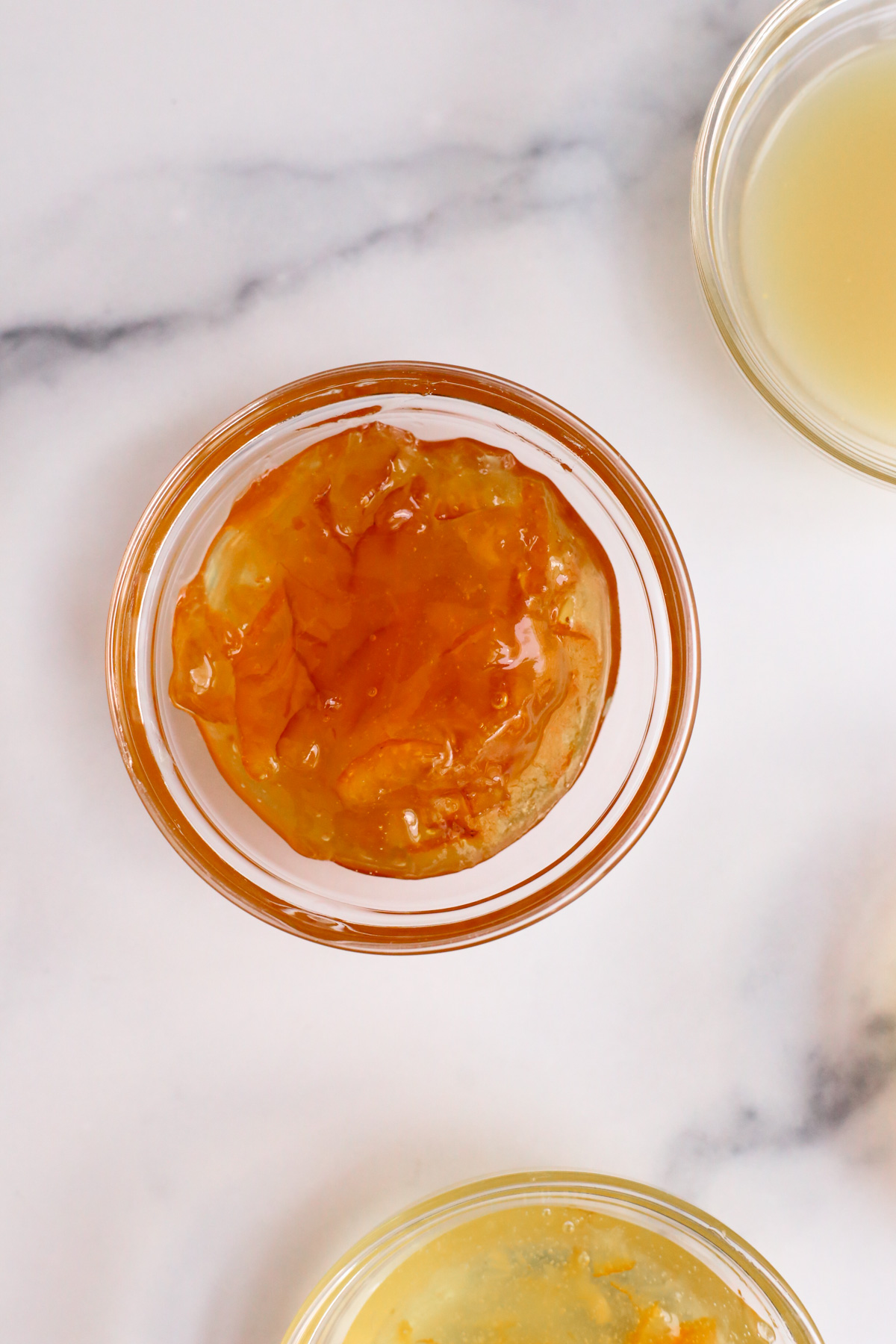
How to Store
If you happen to get lucky and find yourself with some fresh yuzu fruit on your hands, congrats! Take care to store it well to avoid wasting it. Like other citrus, you can store the whole fruit at room temperature. But if you want to stretch the shelf-life up to 2-3 weeks, you can refrigerate it if needed. This will dull the aroma but you can still enjoy the flavorful, tart juice.
As for the rest of the products, it’s always a good rule of thumb to follow the instructions on the label or package. Generally speaking, fresh juice or extract should be stored in the fridge before AND after opening. Yuzu marmalade or puree is fine at room temperature until opening, then should be chilled and kept in the refrigerator.
Cooking with Yuzu
There are a variety of ways to harness this unique flavor in yuzu recipes! Try these ideas to get started:
- For Savory Dishes: try variations of yuzu-marinated fish, seafood, or grilled meat. You can also include it in salad dressings like my Yuzu Vinaigrette with Ginger and Honey, or as a sweet and sour glaze for roasted vegetables or potatoes.
- For Sweet Desserts: I’m picturing a yuzu sorbet or granita, infused cakes or tiramisu, and all kinds of yuzu-flavored creams, curds, or custards inside flaky tarts and pastries
- For Cocktails and Mocktails: My Yuzu Margarita is a must-try for entering the world of yuzu cocktails. But it works well in all kinds of non-alcoholic drinks. And don’t forget the classic yuja-cha from Korean cuisine. Simply stir a small amount of yuzu marmalade into hot or cold water.
- For Enhancing Flavor: I’m still waiting for my chance to make my own yuzu kosho. Until then, I will settle for using yuzu-flavored products in
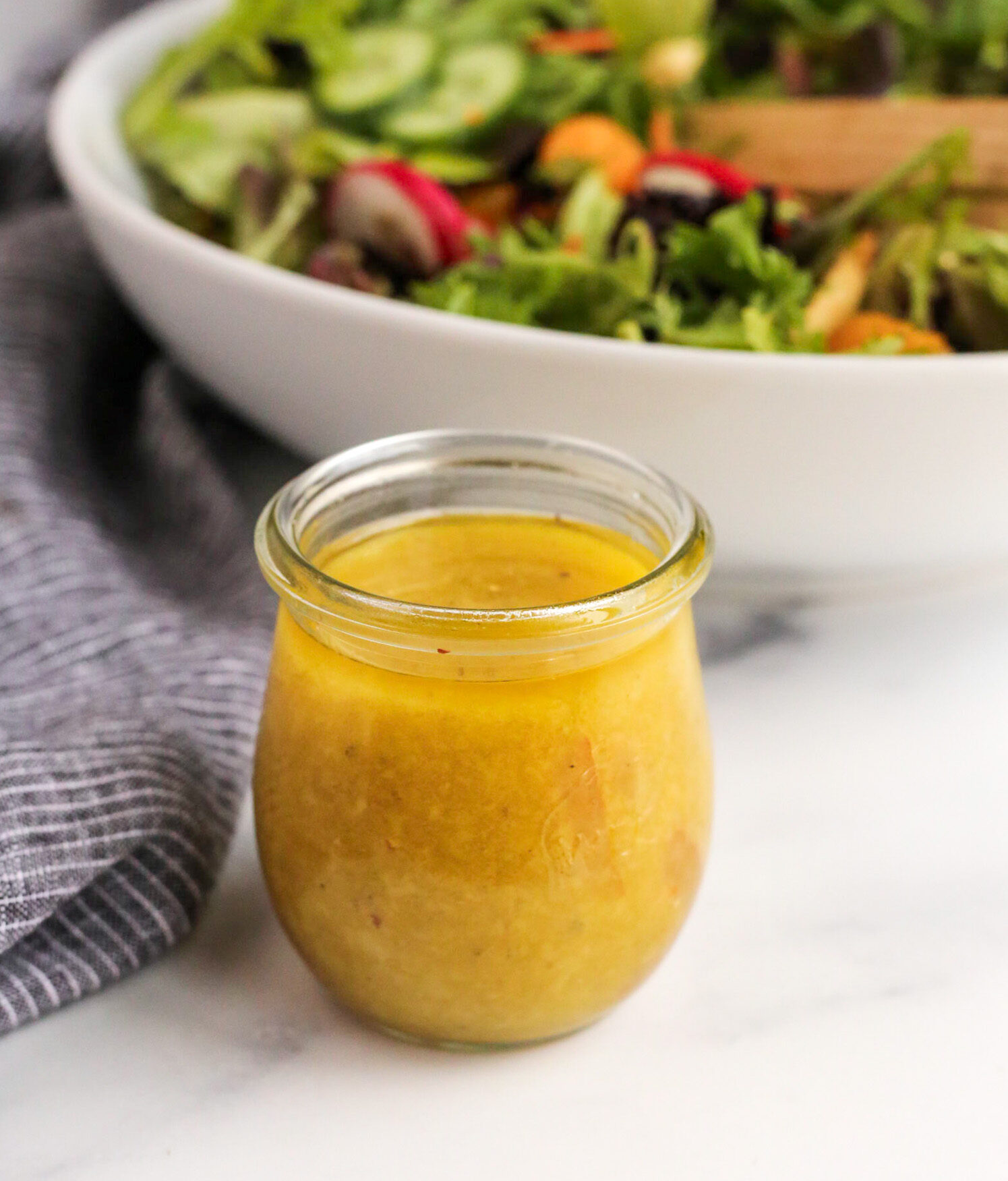
At the end of the day, the ideal way to use it is the way you enjoy it the most. I encourage you to think about the types of recipes and dishes you’re already making. You can ask yourself, “If lemon juice would work, can I try yuzu?” So far, in all my recipe testing efforts, I’ve yet to find a way that didn’t work when using a similar amount and cooking method. And if you’ve come across any interesting uses while dining out or traveling, I would love to hear more. I am really interested to learn how other fans are featuring it, so leave a comment and share!
Although it can be a more expensive and hard-to-find option, cooking with yuzu can be a fun way to experiment in the kitchen. If you like exploring different cuisines or putting your own twist on recipes, you’ll likely have a great time adding yuzu flavor to some of your favorites!
As always, thanks for stopping by the Street Smart Nutrition blog. Until next time, cheers to more fearlessly nourishing meals!



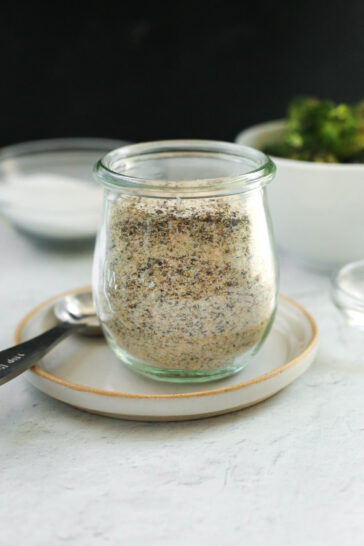










Questions & Reviews